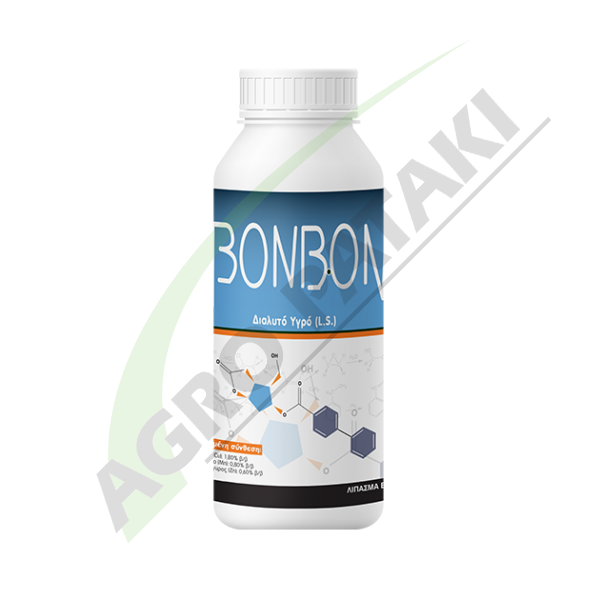- Reducere pe cantitate pana la 8%



Guaranteed composition:
- Total Nitrogen (N): 5.00%
- Copper (Cu): 1.80%
- Manganese (Mn): 0.80%
- Zinc (Zn): 0.60%
Complexing agent (chelating):
Organic acids Bon Bon is a bio-stimulant that contains carbohydrates, other organic elements, nitrogen and trace elements (copper, manganese, zinc). The formulation has a strong stimulating effect by enhancing the plant protection system, due to the balanced proportions of its components.
Bon Bon is recommended for use especially during periods of intensive growth, when the nutritional needs of plants are higher to increase their metabolic activity. It is made from a very penetrating organic element, which provides the plants with components involved in growing, such as zinc and manganese, which stimulate vegetation.
Recommended crops:
- Bon Bon is recommended for all types of crops such as: fruit trees, citrus fruits, olives, vines, vegetables (watermelon, melon, tomatoes, eggplant, pepper, cucumber, pumpkin) etc.It is suitable for both outdoor and greenhouse crops, for nurseries and seedling production.
Recommendations - doses applied:
- Because Bon Bon is completely assimilable, it can be applied foliar or root together with other fertilizers and plant protection products.
- It is recommended to apply in the morning or afternoon.
- It can be used to control and prevent the occurrence of the following diseases in vegetable crops: fusariosis, verticilliosis and Phytophtora.
Dose:
Foliar: 200-500 ml / 100 l
By drip: 3-6 liters / ha
- Vegetables (Greenhouses and open field): 3-5 applications after transplanting and repeat every 3-4 weeks
Foliar: 300-400 ml / 100 l
Root: 3-5 liters / ha
- Fruit trees, Citrus, vines: 3 applications, when entering the vegetation, before flowering and when increasing the size of the fruit.
Foliar: 300-500 ml / 100 l
Root: 4-6 liters / ha
- Cereals, Ornamental plants: 3-4 foliar applications from germination or transplanting repeating every 2-3 weeks with 200-300 ml / 100 l.
- Frames: Foliar or by water bath 100-300 ml / 100 l. Repeat every 7-10 days.
Compatibility:
- Bon Bon is compatible with the most popular fertilizers and plant protection products.
- A small compatibility test is recommended in advance.
- Mixing with oily products is not recommended.
By adminitration of fertilizers specific to the summer period, we take a step towards a more drought-resistant lawn. But let's not forget that the resistance of plants to stress is given by the specific balance of nutrients, both macroelements, nitrogen, phosphorus, potassium in the fertilizer, and the presence of trace elements. Theoretically, every 2 to 3 weeks it would be necessary to supplement the microelements, in order to maintain the balance, and it is good to know that the widely used fertilizers do not contain the necessary microelements for the lawn. The administration of microelements before a period of stress, brings the resistance of the plant. How do we do it? Or foliar, a day or two before mowing the lawn by spraying. We have 2 products with a package of microelements: Plex Mix, it can be sprayed with a concentration of 0.2-0.4%, or Micropower Eco at a concentration of 0.2-0.3%. Both products can also be used for irrigation, and in this way will be absorbed by the root. From Plex Mix we use about 80-100 ml per 100 sqm, and from Micropower Eco 40-50 ml.
Under heat stress the plants become even more sensitive and in 7-10 days receive a thermal stress. This stress will not allow the plant to resume growth. Stress can be alleviated by administering stimulants with free amino acids, such as Cropmax, Formula 20 or BonBon. The latter also has the advantage of preventing some foliar diseases.
Either the uncut lawn has grown in a period of drought, or in a rainy period the density of vegetation leads to foliage disease. A strong disease of lawn is powdery mildew, which just has the period of infection at high temperatures and high humidity. Obviously, by trimming the foliage we will remove the diseased parts, but an installed disease is much harder to fight. There are all kinds of pesticides on the market to fight foliar diseases for grass species, but there is no target for lawn. Instead, I found a product that improves the natural resistance of plants. Basically, cupric pesticides can also be used on lawns to prevent diseases, but they are contact, they remain only on the surface of the lawns, and the first watering washes them and is no longer useful. Ferticupper copper is systemic, penetrates the plant, helps metabolic processes and also gives resistance to plants. If administered together with a urea nitrogen fertilizer (eg Abono N) our lawn acquires a darker shade of green.
The dose per foliar application is 0.4% Ferticupper + 0.3% Abono. A break of 3-4 weeks between treatments is recommended.